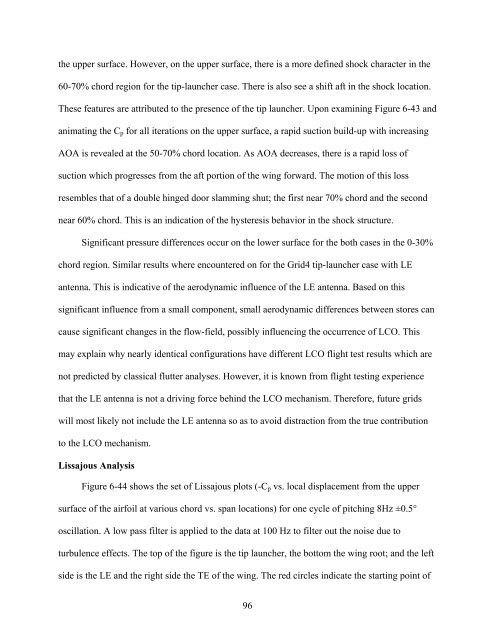university of florida thesis or dissertation formatting template
university of florida thesis or dissertation formatting template
university of florida thesis or dissertation formatting template
Create successful ePaper yourself
Turn your PDF publications into a flip-book with our unique Google optimized e-Paper software.
the upper surface. However, on the upper surface, there is a m<strong>or</strong>e defined shock character in the<br />
60-70% ch<strong>or</strong>d region f<strong>or</strong> the tip-launcher case. There is also see a shift aft in the shock location.<br />
These features are attributed to the presence <strong>of</strong> the tip launcher. Upon examining Figure 6-43 and<br />
animating the Cp f<strong>or</strong> all iterations on the upper surface, a rapid suction build-up with increasing<br />
AOA is revealed at the 50-70% ch<strong>or</strong>d location. As AOA decreases, there is a rapid loss <strong>of</strong><br />
suction which progresses from the aft p<strong>or</strong>tion <strong>of</strong> the wing f<strong>or</strong>ward. The motion <strong>of</strong> this loss<br />
resembles that <strong>of</strong> a double hinged do<strong>or</strong> slamming shut; the first near 70% ch<strong>or</strong>d and the second<br />
near 60% ch<strong>or</strong>d. This is an indication <strong>of</strong> the hysteresis behavi<strong>or</strong> in the shock structure.<br />
Significant pressure differences occur on the lower surface f<strong>or</strong> the both cases in the 0-30%<br />
ch<strong>or</strong>d region. Similar results where encountered on f<strong>or</strong> the Grid4 tip-launcher case with LE<br />
antenna. This is indicative <strong>of</strong> the aerodynamic influence <strong>of</strong> the LE antenna. Based on this<br />
significant influence from a small component, small aerodynamic differences between st<strong>or</strong>es can<br />
cause significant changes in the flow-field, possibly influencing the occurrence <strong>of</strong> LCO. This<br />
may explain why nearly identical configurations have different LCO flight test results which are<br />
not predicted by classical flutter analyses. However, it is known from flight testing experience<br />
that the LE antenna is not a driving f<strong>or</strong>ce behind the LCO mechanism. Theref<strong>or</strong>e, future grids<br />
will most likely not include the LE antenna so as to avoid distraction from the true contribution<br />
to the LCO mechanism.<br />
Lissajous Analysis<br />
Figure 6-44 shows the set <strong>of</strong> Lissajous plots (-Cp vs. local displacement from the upper<br />
surface <strong>of</strong> the airfoil at various ch<strong>or</strong>d vs. span locations) f<strong>or</strong> one cycle <strong>of</strong> pitching 8Hz ±0.5°<br />
oscillation. A low pass filter is applied to the data at 100 Hz to filter out the noise due to<br />
turbulence effects. The top <strong>of</strong> the figure is the tip launcher, the bottom the wing root; and the left<br />
side is the LE and the right side the TE <strong>of</strong> the wing. The red circles indicate the starting point <strong>of</strong><br />
96
















